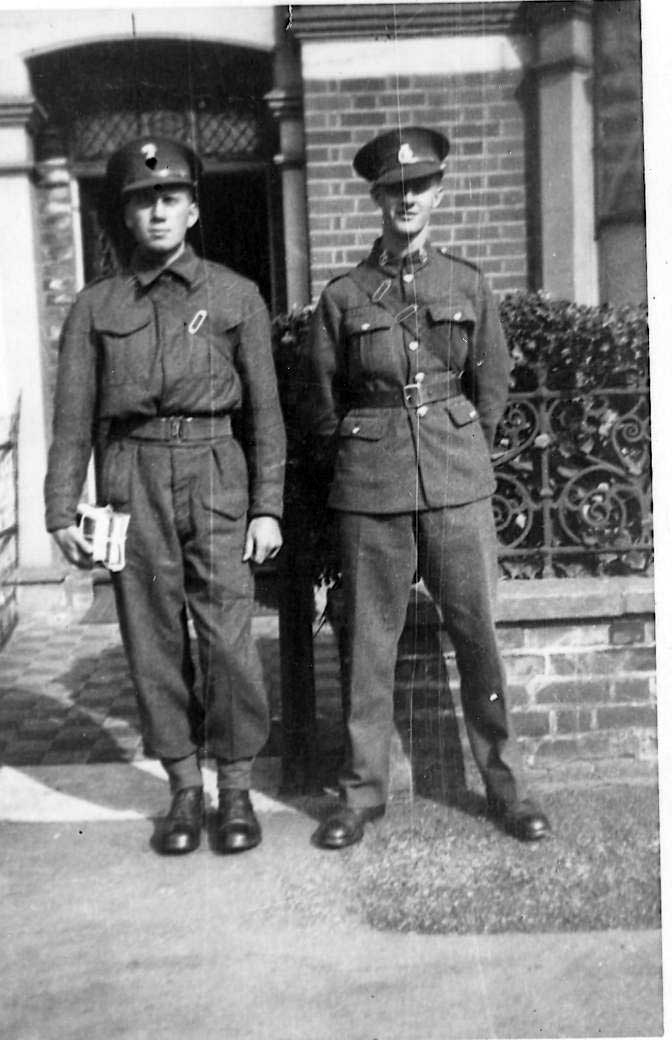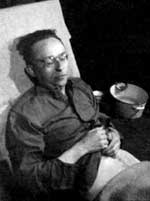- [See
also the facsimile of Britton's original
version]
[and
another version]
-

Arthur Britton (left) in England, probably Windsor
[source]
-
-
Top of
first page marked in ink: "Sep.
Doc, Envelope 2387." and
numbered: "HQ 0426"
THE CAPTURE OF
HEINRICH HIMMLER AND OTHER LEADING NAZIS MAY
1945 [account by Sergeant
Britton] ON 6th May 1945 at Plön, Heinrich
Himmler, the Reichsführer SS, C in C of
the Reserve Army, Reichsminister of the Interior,
and Chief of Police, was dismissed from his offices
by Grand Admiral Doenitz, the new head of
the German state after Hitler's suicide. The
dreaded Himmler, one of Hitler's earliest and most
trusted colleagues had become head of the SS,
Hitler's elite bodyguard, and as Chief of
Police and Interior Minister had been responsible
for the SS -- Death's Head Concentration Camp
guards -- the largest mass-murder organisation
known in history. Admiral Doenitz hated and
distrusted Himmler and would have no truck with
him, so the SS leader decided to go South to his
home in Bavaria, taking with him a few escorts,
medical advisers and ADCs. Disguising themselves
and holding false papers, the party 12 strong, left
Flensburg on 10th May. Himmler had documents
purporting to show that he was "Ex Sergeant
Heinrich Hitzinger of a Special Armoured Company,
attached to the Secret Field Police, demobilised on
3 May 1945". This curiously unsuitable cover-name
meant that he was still in an automatic arrest
category. He wore a civilian jacket, shaved off his
moustache, removed his pince-nez glasses, and
donned an eye patch over his left eye. Crossing the Elbe estuary by boat they then
mixed with a great mass of German troops of all
services who were hemmed into the peninsula formed
by the Rivers Elbe and Ems and the North Sea Coast.
They moved South by easy stages to
Bremervörde, a small town on the little river
Oste which they reached on 18th May; though they
could have crossed this river elsewhere, they
decided to use the bridge which was guarded by
British troops of the 51st Highland Division.
Acting on British 2nd Army reports, a check point
had been established here by 45 Field Security
Section (attached to HQ 30 Corps) based at Zeven a
few kilometres further south. Himmler and two of his escorts, a Waffen SS Lt
Col and a Major walked through Bremervörde on
22 May towards the check point, and a bizarre sight
they must have been. The two escorts in front were
clearly military men in long green overcoats, while
the dreaded mass-murderer himself looked
insignificant in an odd selection of civilian
garments with a blue raincoat on top. To make
matters worse, the two officers glanced back from
time to time to ensure that their charge was still
with them. This odd trio was picked up by an alert
British infantry patrol, not knowing who they were,
and were brought in to the check point. Here
Sergeants Arthur Britton
[author of this
postwar report] and Ken
Baisbrown of 45 Field Security Section, and
Staff Sergeant John Hogg of 1003 Field
Security Reserve Detachment made out the arrest
documents after a quick scrutiny of the false
identity papers, and realisation that all three
were in an automatic arrest category. The true
identity of the second greatest German war criminal
of them all did not come to light for another
couple of days. He was allowed some refreshment and a floor to
sleep on at the check point that night and next
morning, 23 May, was sent on to No 031 Civil
Internment Camp at Barnstedt; Sgt Britton drove the
truck with the three prisoners, and on the way
checked in at HQ 45 FSS at Zeven, where the OC
Captain Excell sent them straight on to the
Internment Camp for full processing. Around 7 pm
that night Himmler asked for an interview with the
Camp Commandant, Captain Thomas Selvester,
and for some reason revealed his true identity. An
Intelligence Officer was quickly sent by HQ 2nd
Army nearby, bearing a specimen signature of
Himmler's which was checked against the prisoner's
signature, and identification was complete. Two body searches and a complete change of
clothing failed to reveal any hidden poisons, and
at 9.45 pm Colonel Michael
Murphy, Chief of Intelligence at HQ 2nd
British Army arrived to take personal charge of the
prisoner. He immediately arranged for a medical
search to be carried out at Luneburg and at 10.45
pm it was done by Captain Wells RAMC, the HQ
Medical Officer, now deceased [Wells died on
August 15, 1975], but who left a written
account of the affair.  Having
searched the prisoner thoroughly he came to the
mouth, where he noticed a small blue tit-like
object sticking out of the lower sulcus of the left
cheek. He slipped his finger into the prisoner's
mouth to sweep out what he had seen but Himmler
immediately clamped down on the doctor's fingers,
they struggled, he wrenched his head away, crushed
the glass capsule between his teeth, and the
cyanide did its deadly work in some ten
minutes. Having
searched the prisoner thoroughly he came to the
mouth, where he noticed a small blue tit-like
object sticking out of the lower sulcus of the left
cheek. He slipped his finger into the prisoner's
mouth to sweep out what he had seen but Himmler
immediately clamped down on the doctor's fingers,
they struggled, he wrenched his head away, crushed
the glass capsule between his teeth, and the
cyanide did its deadly work in some ten
minutes.
The arch criminal underwent autopsy and formal
identification by Allied staff officers and was
buried in an unmarked grave outside Lüneburg
on 25 May 1945. While these events were going on 61 FSS and
troops of 11th Armoured Division arrested Grand
Admiral Dönitz and members of his interim
government at Flensburg on 22 May while 53 FSS
[attached
to] the VIII Corps HQ Section at
Lübeck arrested the Commandant of
Sachsenhausen Concentration Camp. Von
Ribbentrop, Hitler's Foreign Minister was
picked up to [sic] FS personnel in Hamburg
at about the same time. 61 FSS had another big haul
of wanted men on 23 May when they captured Colonel
General Jodl, General Major Dethleffsen, Admiral
Wagner, two Reichsministers and six State
Secretaries. The Section's official report to GSI
(b) at HQ VIII Corps described their difficulties
in gathering in the bodies and their documents, as
Press Teams and Shaef observers were wrongly
allowed to accompany the arrest task force. These
onlookers "lifted" souvenirs such as watches and
wallets, which in the case of Category I arrests
may well have contained highly important
evidence. Penciled
note at foot of last page: "This story agreed by Mr
Neil McDermott Q.C. formerly GSO1 (Int b) at
HQ 21st Army Group, though he added that a gentle
interrogation by M.I.5 reps also took place.
TGR" Each
page is marked in ink, "Copy of document. Int.
Corps Archives. A/E [Major (ret.) Alan
Edwards] 7/10.05." Edwards states October
6, 2005: "I also found a most detailed report
prepared by a Sgt Britton who arrested Himmler.
This material was written at the time Mr Ramsey was
preparing his article [for After the
Battle magazine]." Spelling and
transcription errors have been corrected here.
Items in brackets [ ] were inserted by this
website 2005 and 2010. 
 Heinrich
Himmler dossier | Statement
by Sergeant Britton on arrest of
Himmler
Heinrich
Himmler dossier | Statement
by Sergeant Britton on arrest of
Himmler Dossier on
death of Heinrich Himmler
Dossier on
death of Heinrich Himmler-
 Statement
dated February 11, 1964, by former colonel
(British Army) Michael Murphy on the death of
Heinrich Himmler, May 1945
Statement
dated February 11, 1964, by former colonel
(British Army) Michael Murphy on the death of
Heinrich Himmler, May 1945
|